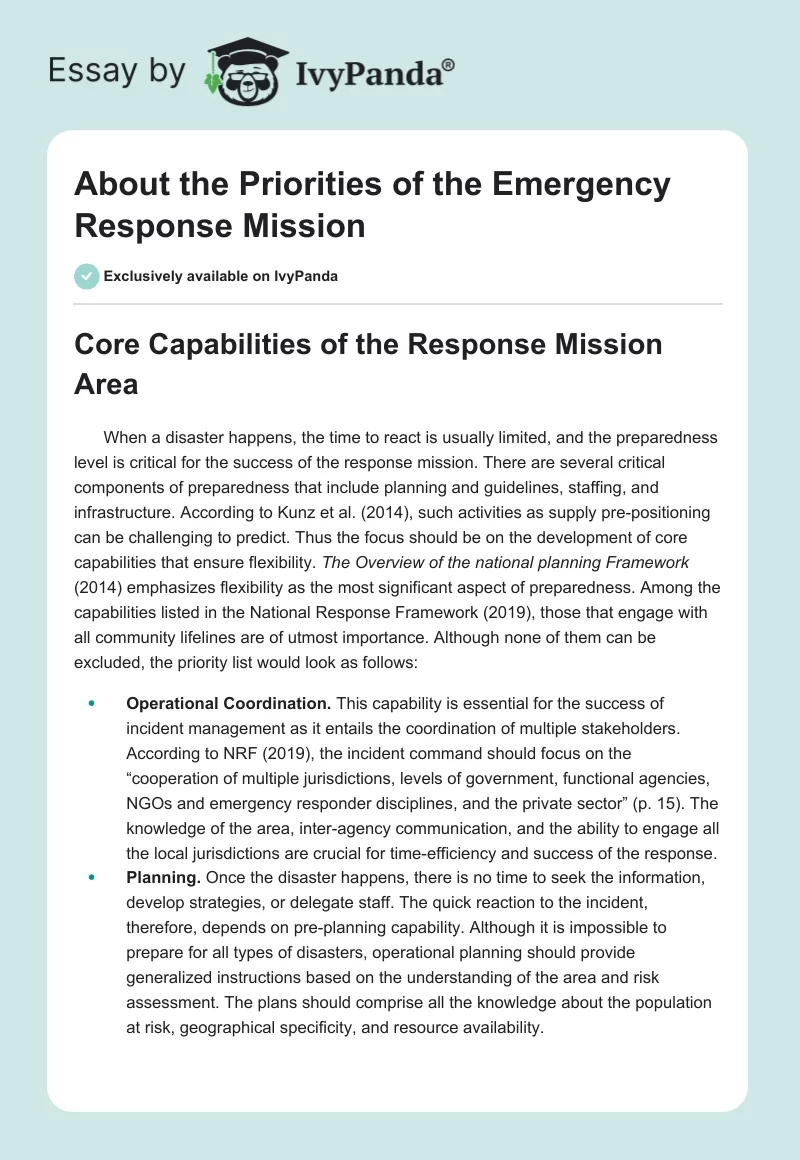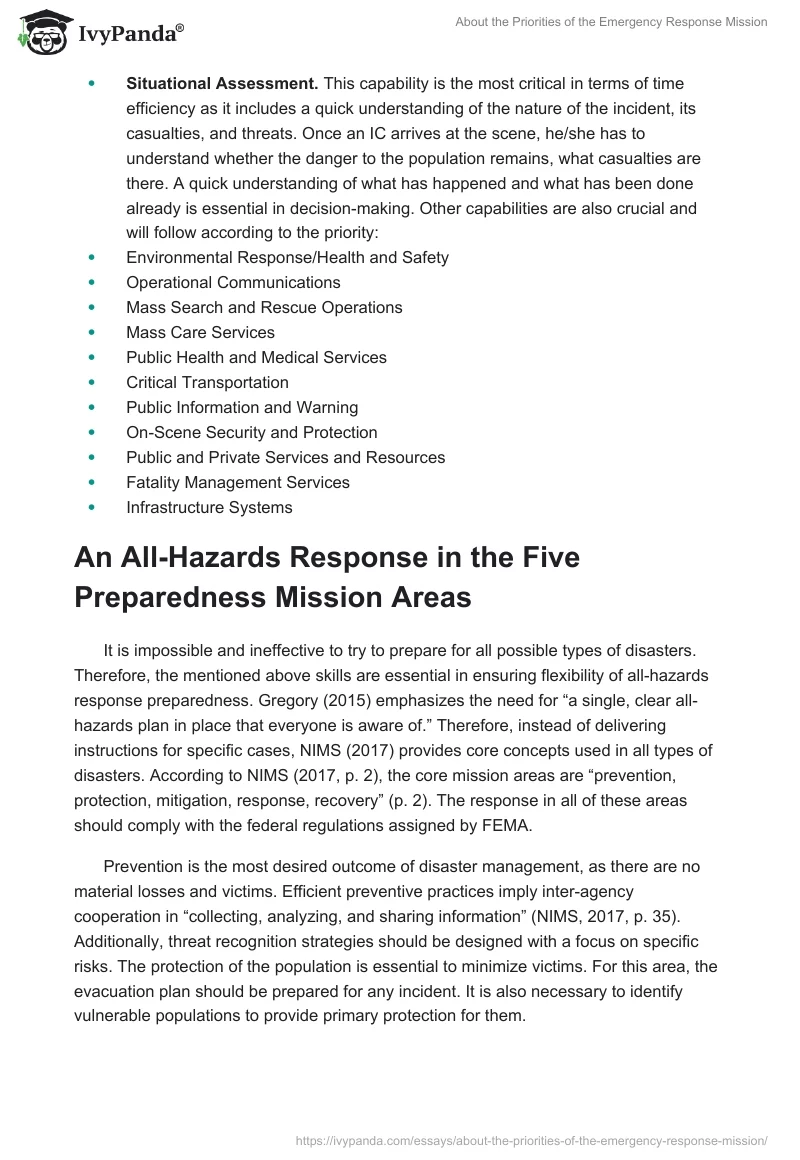Core Capabilities of the Response Mission Area
When a disaster happens, the time to react is usually limited, and the preparedness level is critical for the success of the response mission. There are several critical components of preparedness that include planning and guidelines, staffing, and infrastructure. According to Kunz et al. (2014), such activities as supply pre-positioning can be challenging to predict. Thus the focus should be on the development of core capabilities that ensure flexibility. TheOverview of the national planning Framework (2014) emphasizes flexibility as the most significant aspect of preparedness. Among the capabilities listed in the National Response Framework (2019), those that engage with all community lifelines are of utmost importance. Although none of them can be excluded, the priority list would look as follows:
- Operational Coordination. This capability is essential for the success of incident management as it entails the coordination of multiple stakeholders. According to NRF (2019), the incident command should focus on the “cooperation of multiple jurisdictions, levels of government, functional agencies, NGOs and emergency responder disciplines, and the private sector” (p. 15). The knowledge of the area, inter-agency communication, and the ability to engage all the local jurisdictions are crucial for time-efficiency and success of the response.
- Planning. Once the disaster happens, there is no time to seek the information, develop strategies, or delegate staff. The quick reaction to the incident, therefore, depends on pre-planning capability. Although it is impossible to prepare for all types of disasters, operational planning should provide generalized instructions based on the understanding of the area and risk assessment. The plans should comprise all the knowledge about the population at risk, geographical specificity, and resource availability.
- Situational Assessment. This capability is the most critical in terms of time efficiency as it includes a quick understanding of the nature of the incident, its casualties, and threats. Once an IC arrives at the scene, he/she has to understand whether the danger to the population remains, what casualties are there. A quick understanding of what has happened and what has been done already is essential in decision-making. Other capabilities are also crucial and will follow according to the priority:
- Environmental Response/Health and Safety
- Operational Communications
- Mass Search and Rescue Operations
- Mass Care Services
- Public Health and Medical Services
- Critical Transportation
- Public Information and Warning
- On-Scene Security and Protection
- Public and Private Services and Resources
- Fatality Management Services
- Infrastructure Systems
An All-Hazards Response in the Five Preparedness Mission Areas
It is impossible and ineffective to try to prepare for all possible types of disasters. Therefore, the mentioned above skills are essential in ensuring flexibility of all-hazards response preparedness. Gregory (2015) emphasizes the need for “a single, clear all-hazards plan in place that everyone is aware of.” Therefore, instead of delivering instructions for specific cases, NIMS (2017) provides core concepts used in all types of disasters. According to NIMS (2017, p. 2), the core mission areas are “prevention, protection, mitigation, response, recovery” (p. 2). The response in all of these areas should comply with the federal regulations assigned by FEMA.
Prevention is the most desired outcome of disaster management, as there are no material losses and victims. Efficient preventive practices imply inter-agency cooperation in “collecting, analyzing, and sharing information” (NIMS, 2017, p. 35). Additionally, threat recognition strategies should be designed with a focus on specific risks. The protection of the population is essential to minimize victims. For this area, the evacuation plan should be prepared for any incident. It is also necessary to identify vulnerable populations to provide primary protection for them.
Mitigation is lessening the disaster’s impact on the population and reduction of losses. This aim is achieved through resource management, which includes assessment of the resource vulnerability and design of resupplying strategies (NIMS, 2017). The primary purpose of the response is to save human lives through rescue missions and healthcare mobilization. The preparedness should include planning on how to deliver humanitarian, medical, informational, and psychological help. Recovery is the final stage of disaster management that means assistance to the community in getting back to regular life. Generally, humanitarian aid can be prolonged, and local actors should be provided with the instruments for disaster recovery.
The Role of Deputy Incident Commanders
Often, a Deputy IC is assigned to the Incident Commander to assist in response management. The officer’s main requirement is to be fully qualified to perform the commander position, as he/she can function as a relief. There can be either one or several Deputies assigned usually from the same organization as the Incident Commander. According to NIMS (2017), a Deputy “can be delegated the authority to manage a functional operation or to perform a specific task” (p. 63). NIMS (2017) identifies three reasons for the designation of a Deputy IC:
- Performance of the assignments delegated by the Incident Commander. An example of this situation can be when the Deputy IC visits a press conference or a meeting as commissioned by the CommanderCommander. Such actions are often necessary when there is a need for a commander to perform many tasks simultaneously.
- Acting in a relief capacity. For example, a deputy can take over the following stage of the response.
- Representation of another agency if there is a shared jurisdiction. When two organizations have authority over the response management, a deputy from one of them can be assigned to the Commander from another to establish mutual work.
Five Tenets of Working in Chaos
Although some disasters fall into the category of known and understandable, others can develop in chaos where guidelines are of little help, and the Commander has to have skills to restore order. According to Renaud (2012), NIMS is efficient when the order has been restored, but the onset of the disaster can be non-linear and chaotic. Therefore five principles ensure effective work on the edge of chaos.
- Finding the right person to do the job. The role of the IC, who is the first on the scene, is essential in restoring order. This person should “set the initial tone, pace, and direction of the response efforts” (Renaud, 2012, p. 7). The point is that the person should not only be trained for this role but also should possess natural qualities for working under stress.
- The importance of adaptive thinking. Often, incidents do not go according to the guidelines; therefore, sense-making is essential. This tenet concerns those incidents that are both complex and chaotic.
- Creativity and control over people. Manipulation should not be feared in disaster response management. During inter-agency cooperation, there is no possibility to distribute orders, and people can be manipulated to work together. Additionally, improvisation is essential as ordered checklists do not work in chaos.
- Finding core connections. As establishing cooperation takes time, it is essential to find primary social links in the community and utilize them. This approach helps to restore order and save “golden hours.”
- There is no timely arrival. Any incident commander should realize and accept the fact that he/she cannot arrive directly at the moment of disaster onset. As the response operation begins, some chaotic rescuing activity can already be going on. Therefore, it is vital to assess the stage of the incident and what has been done already.
References
Gregory, P. A. (2015). Reassessing the effectiveness of all-hazards planning in emergency management. Inquiries Journal, 7(6).
Kunz, N., Reiner, G., & Gold, S. (2014). Investing in disaster management capabilities versus pre-positioning inventory: A new approach to disaster preparedness. International Journal of Production Economics, 157, 261-272.
National Incident Management System (NIMS). (2017). FEMA.
National Response Framework (NRF). (2019). Homeland Security.
Overview of the national planning frameworks. (2014). Homeland Security.
Renaud, C. (2012). The missing piece of NIMS: Teaching incident commanders how to function at the edge of chaos. The Journal of the Naval Postgraduate School Center for Homeland Defence and Security, 8(8), 1-18.


